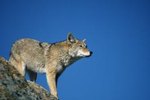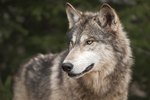
Gray wolves are rare in Europe and the United States, but they still live throughout Canada, Alaska and Asia. They live and hunt in packs of six to 10. They communicate with each other and other packs using scent, body language and vocalizations. Wolves use four basic vocalizations in communication.
Howl
A wolf's howl can be heard up to 10 miles away and is used to communicate over long distances. Howling may be a social message to call the pack together, or to locate pack members. Alternatively, wolves may howl to protect a kill or define their territory. Pack howling may also be a form of social bonding. Most howling occurs in the morning and evening hours and increases during breeding season from January to March.
Types of Howls
Wolves use three types of howls. A chorus howl is when multiple pack members howl together. During the chorus howl, wolves are resting in standing, sitting or lying-down positions. The rally howl takes place between pack members, usually the alpha male and female, as they approach each other. The rally howl may be in response to the howls of another pack of wolves or coyotes. Finally, the solo howl is the howl of a single wolf. This howl rises in frequency and is less full-throated than the chorus howl.
Growl
Wolves usually bare their teeth to growl to warn off other wolves or establish position within the pack. Growling can escalate to aggression and fighting if one wolf does not submit to the other.
Bark
Wolves bark to warn the pack of danger or to express nervousness or excitement. Barking is also a greeting to other pack members. A bark is usually a "whuf" sound that is low-pitched and breathy. In some cases wolves will add a howl to the end of a bark.
Whine
Mother wolves will whimper or whine to indicate to her cubs that she will nurse them. Whimpering may also indicate submission to a more dominant wolf in the pack.
References
Photo Credits
-
NA/AbleStock.com/Getty Images
Writer Bio
Maureen Malone started writing in 2008. She writes articles for business promotion and informational articles on various websites. Malone has a Bachelor of Science in technical management with an emphasis in biology from DeVry University.




